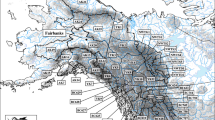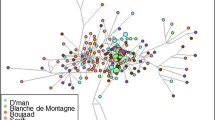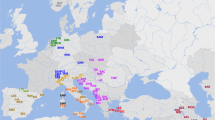Abstract
Bighorn sheep populations experienced a drastic reduction in both distribution and abundance until the advent of modern wildlife management, where improving viability of extant populations and translocating animals into historical habitat range have been the most important management policies. The fact that subspecies relationships among bighorn are ambiguous,together with the importance of selecting appropriate source stock and the expense of translocation projects, makes an understanding of subspecies relationships and genetic variation, within and between populations, important for the management and conservation of this species. In this study, genetic variation in 279 bighorn sheep from 13 study sites in Arizona, California, New Mexico and Alberta, Canada were examined by analyzing ten microsatellite loci to determine interpopulation differentiation and relationships between closely related taxa. All populations contained a substantial amount of genetic variation. Genetic differences between populations were large and roughly proportional to geographic distance. The significance of this to desert subspecies relationships and management is discussed.
Similar content being viewed by others
References
Ashley MV, Dow BD (1994) The use of microsatellite analysis in population biology: background, methods, and potential applications. In: Molecular Ecology and Evolution: Approaches and Application (eds. Scherwater B, Strait B, Wagner GP, Desalle R), pp. 185–201. Birkhauser Verlag, Basel.
Berger J (1990) Persistence of different sized populations: an empirical assessment of rapid extinctions in bighorn sheep. Cons. Biol., 4, 91–98.
Bleich VC, Wehausen JD, Ramey RR, Rechel JL (1995) Metapopulation theory and mountain sheep: implications for conservation. In: Metapopulations and Wildlife Conservation Management (ed. McCullough D), pp. 353–373. Island Press, San Francisco.
Boyce WM, Hedrick PW, Muggli-Cockett NE, Kalinowski S, Penedo MCT, Ramey RR (1997) Genetic variation of major histocompatibility complex and microsatellite loci: a comparison in bighorn sheep. Genetics, 145, 421–433.
Brown D (1993) Early history in the desert bighorn sheep in Arizona. In: Desert Bighorn Sheep (ed. Lee RM), pp. 1–9. Arizona Game and Fish Department, Phoenix, Arizona.
Buchanan FC, Littlejohn RP, Galloway SM, Crawford AM (1993) Microsatellite and associated repetitive elements in the sheep genome. Mammal. Genome, 4, 58–264.
Buechner HK (1960) The bighorn sheep of the United States: its past, present and future. Wildlife Monogr., 4, 1–174.
Cowan IM (1940) The distribution and variation in the native sheep of North America. Amer. Midl. Natur., 24, 505–580.
Crawford AM, Montgomery GW, Pierson CA, Brown T, Dodds KG, Sunden SLF, Henry HM, Ede AJ, Swarbrick PA, Berryman T, Penty JM, Hill DF (1994) Sheep linkage mapping: nineteen linkage groups derived from the analysis of paternal half-sib families. Genetics, 137, 573–579.
DeForge JR, Jenner CW, Plechner AP, Sudmeier GW (1979) Decline of bighorn sheep (Ovis Canadensis), the genetic implications. Desert Bighorn Coun. Trans., 23, 63–65.
Environmental System Research Institute (ESRI) (1998) ARCVIEW 3.0a. Redlands, CA.
Feldman MW, Bergman A, Pollock DD, Goldstein DB (1997) Microsatellite genetic distances with range constraints: analytic 15 description and problems of estimation. Genetics, 145, 207–216.
Felsenstein J (1993) PHYLIP- (phylogeny inference package), version 3.5c. University of Washington, Seattle.
Forbes SH, Hogg JT, Buchanan FC, Crawford AM, Allendorf FW (1995) Microsatellite evolution in congeneric mammals: domestic and bighorn sheep. Molec. Biol. Evol., 12, 1106–1113.
Forbes SH, Hogg JT (1999) Assessing population structure at high levels of differentiation: microsatellite comparisons of bighorn sheep and large carnivores. Anim. Cons., 2, 223–233.
Hedrick PW, Miller PS (1992) Conservation genetics: techniques and fundamentals. Ecol. Applic., 2, 30–46.
Hedrick PW (1999) Perspective: highly variable loci and their interpretation in evolution and conservation. Evolution, 53, 313–318.
Jarne P, Lagoda PJL (1996) Microsatellites, from molecules to populations and back. Trends Ecol. Evol., 11, 424–429.
Jesup DA, Ramey RR (1995) Genetic variation of bighorn sheep as measured by blood protein electrophoresis. Desert Bighorn Coun. Trans. 39, 17–25.
Lee RM (1998) The Desert Bighorn Sheep in The Wild Sheep Journal. Foundation for North American Wild Sheep. Cody, Wyoming, pp. 51–56.
Mantel N (1967) The detection of disease clustering and a generalized regression approach. Cancer Res., 27, 209–220.
Monson G (1990) Distribution and abundance. In: The Desert Bighorn Sheep: Its Life History, Ecology and Management (eds. Monson G, Sumner L), pp. 40–51. Univ. Arizona Press, Tucson, Arizona.
Nauta MJ, Weissing FJ (1996) Constraints on allele size at microsatellite loci: implications for genetic differentiation. Genetics, 143, 1021–1032.
Nei M (1977) F-statistics and analysis of gene diversity in subdivided population. Annals Hum. Genet., 41, 225–233.
Nei M (1987) Molecular Evolutionary Genetics. Columbia University Press, New York.
Ota T (1993) DISPAN: Genetic Distance and Phylogenetic Analysis. Institute of molecular evolutionary genetics. Pennsylvania State University.
Ramey RR (1995) Mitochondrial DNA variation, population structure, and evolution of mountains sheep in the southwestern United States and Mexico. Mol. Ecol. 4, 429–439.
Raymond M, Rousset F (1995) GENEPOP 1.02: population genetics software for exact tests and ecumenicism. J. Hered., 86, 248–249.
Rice WR (1989) Analyzing tables of statistical tests. Evolution, 43, 223–225.
Rubin ES, Boyce WM, Jorgensen MC, Torres SG, Hayes CL, O'Brien CS, Jessup DA (1998) The distribution and abundance of bighorn sheep in the Peninsular Ranges, California. Wildlife Soc. Bull., 26, 539–551.
Sambrook J, Fritsch FE, Maniatis T (1989) Molecular Cloning: A Laboratory Manual. Cold Spring Harbor Press, New York.
Sausman KA (1984) Survival of captive-born Ovis Canadensis in North American zoos. Zoo Biol., 3, 111–121.
Schwartz OA, Bleich VC, Holl SA (1986) Genetics and the conservation of mountain sheep Ovis canadensis nelsoni. Biol. Cons., 37, 179–190.
Slatkin M (1995) A measure of population subdivision based on microsatellite allele frequencies. Genetics, 139, 457–462.
Smith TB, Wayne RK (eds.) (1996) Molecular Genetic Approaches in Conservation. Oxford Univ. Press, New York.
Sokal RR, Rohlf FJ (1995) Biometry, 3rd Ed., W. H. Freeman, San Francisco.
Steffen P, Eggen A, Dietz AB, Womack JE, Stranzinger G, Fries R (1993) Isolation and mapping of polymorphic microsatellites in cattle. Anim. Genet., 24, 121–124.
Wehausen JD, Ramey RR (1993) A morphometric reevaluation of the peninsular bighorn subspecies. Desert Bighorn Coun. Trans., 37, 1–10.
Author information
Authors and Affiliations
Corresponding author
Rights and permissions
About this article
Cite this article
Gutiérrez-Espeleta, G.A., Kalinowski, S.T., Boyce, W.M. et al. Genetic variation and population structure in desert bighorn sheep: implications for conservation. Conservation Genetics 1, 3–15 (2000). https://doi.org/10.1023/A:1010125519304
Issue Date:
DOI: https://doi.org/10.1023/A:1010125519304




